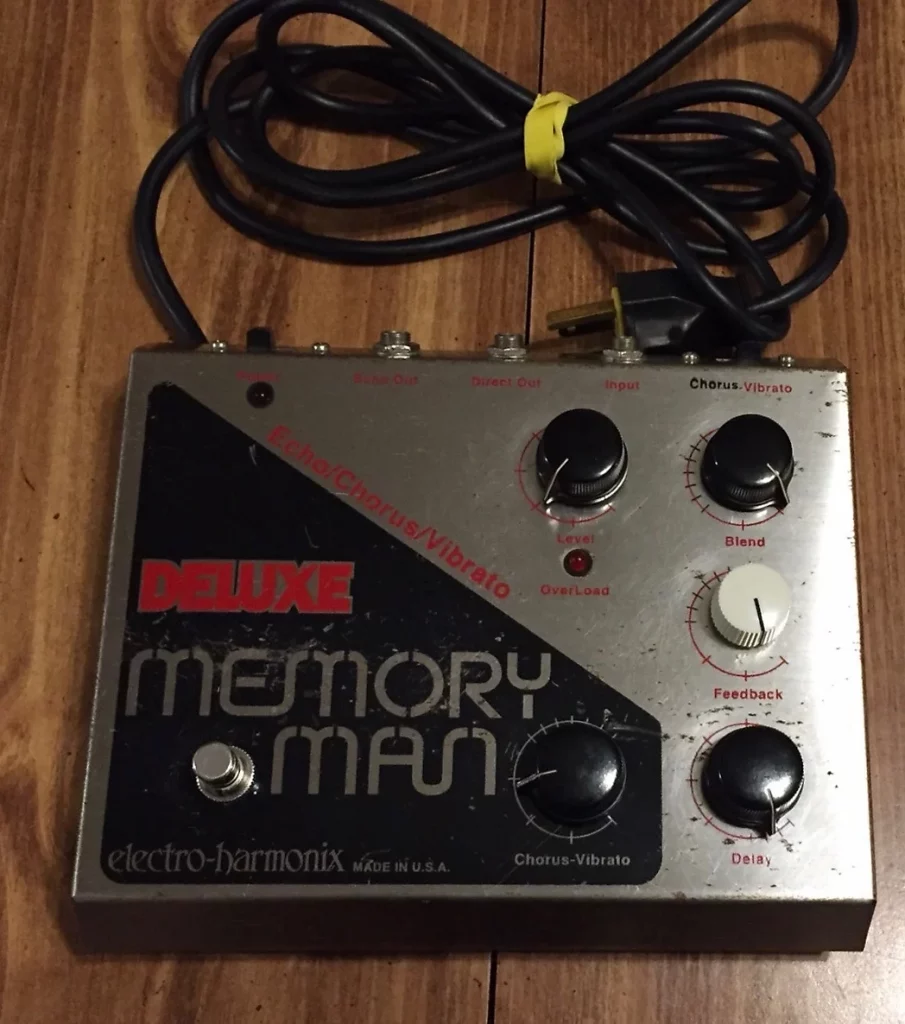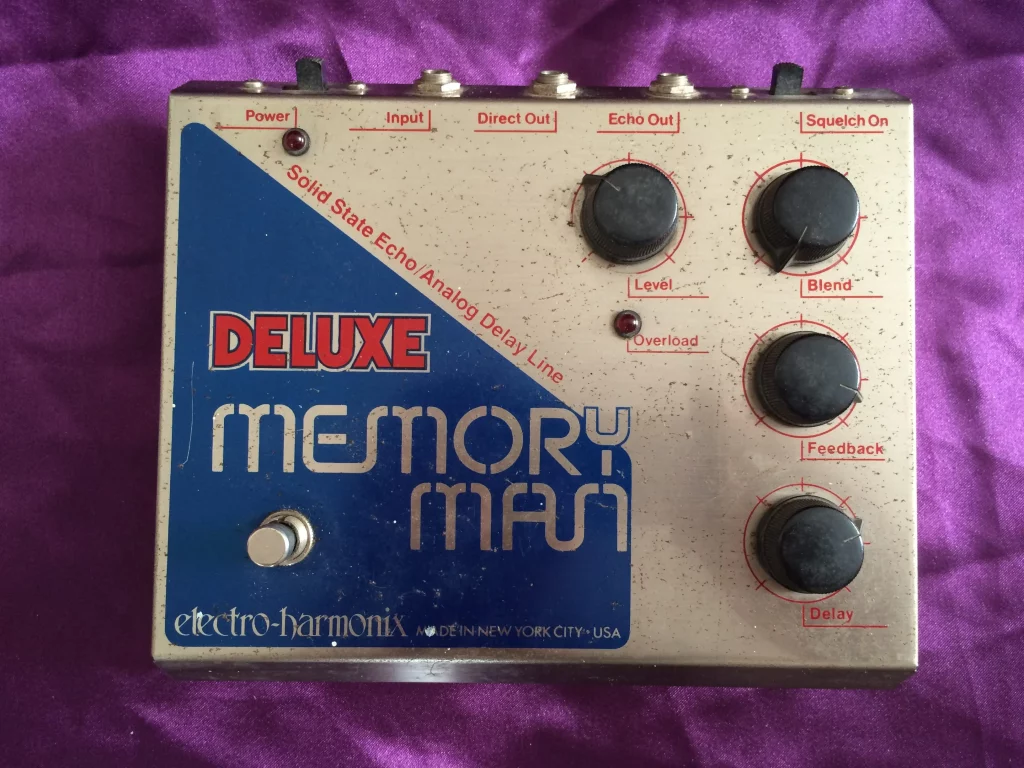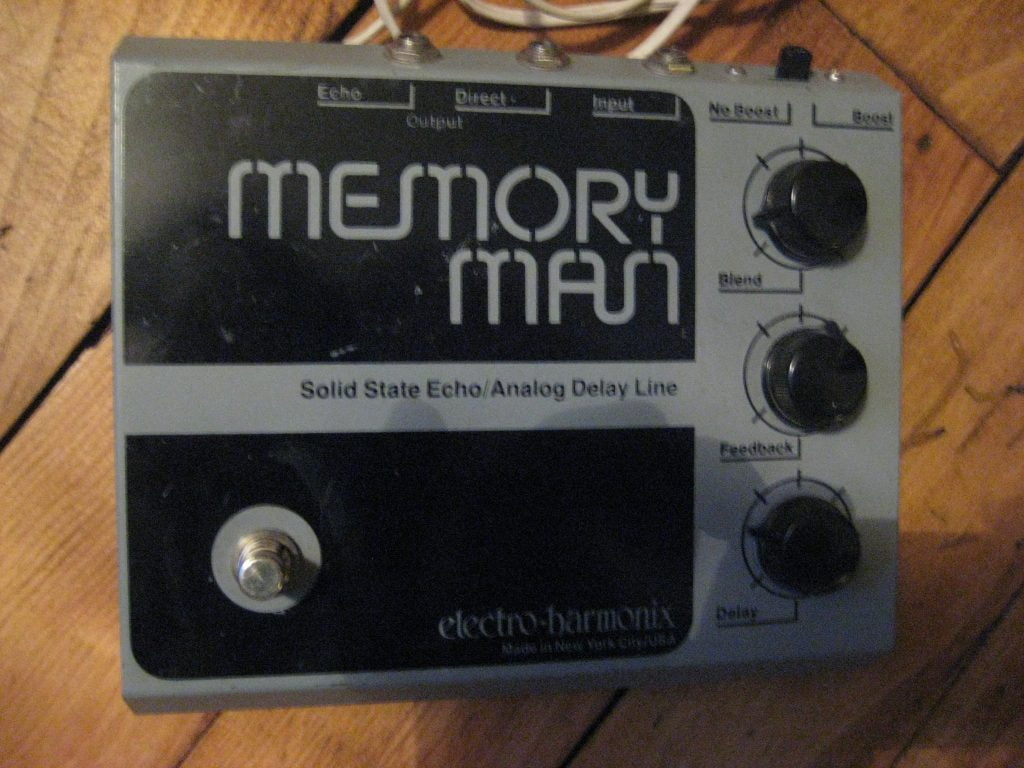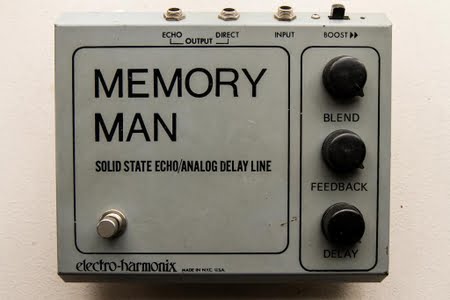Sound of speed: Electro Harmonix Memory Man Deluxe (Vintage vs. Reissues)
This article was originally written by myself under the pseudonym punX on 17 April 2010 on my now defunct MusicGear-Reviews.com website.
Sound of Speed
The Electro Harmonix Memory Man Deluxe has been in production since the late 1970s and, the odd upgrade or modification aside, hasn’t changed much since. Electro Harmonix has recently introduced the first major upgrade of its delay and echo units in 30 years. This article is looking at the original vintage models and subsequent reissues from the early 1990s up to very recently.
Renowned for its warm, analogue tone and organic, watery modulation, the Memory Man Deluxe has achieved a cult status amongst guitarists.
Its most famous user is without doubt The Edge. U2’s tone-meister has been using the Memory Man Deluxe especially in the band’s early days to create his shimmering, otherworldly guitar crescendos.
In a bid to stay competitive, Electro Harmonix have shrunk the size of the rather immense enclosure of the older models and added a number of features to its delay and echo pedals. Production of the ‘original’ Memory Mans has now been discontinued.
Still, there are players searching the second-hand market for vintage models. What’s so special about this delay box that would make anyone choose the vintage Electro Harmonix Memory Man Deluxe over more contemporary models?
Why would anyone want to pay inflated prices for, well, often rusty and beaten up models that lack the sweet features current models from Electro Harmonix or other companies are offering?
To be honest, most players will probably be better off with delay units with modern features. Anything from tap tempo, delay time readouts, presets and all those other fancy features, you won’t find these with vintage Memory Man units.
The simple truth about the Memory Man Deluxe is its amazing tone. Like a Telecaster, versatility is not top of the list but what it does, it does it better than anyone else in the game. It’s as simple as that.
Cornel Lazar in "The Sound of Speed"
What to look out for when searching for vintage models?
First of all buyers should know the differences between the various productions of Deluxe models with the same large enclosure.
The original models were manufactured in the late 70s to early 80s, before Electro Harmonix entered a decade of changes that saw production being outsourced to Russian valve manufacturer Sovtek. During this period the Memory Man production was halted.
Electro Harmonix regained its independence in the early 1990s. Classic models such as the Memory Man series returned and stayed in production until Electro Harmonix decided to overhaul its entire effect pedal models in 2007.
The early 1990’s reissues are the closest to the vintage models and for reasons I’ll explain shortly, are my personal favourites.
Deluxe = Modulation
The Deluxe series offers 5 large knobs on the top of the units to adjust gain (preamp), delay time, feedback (echo repeats), blend (wet/dry) and modulation. 2 modulation types are offered, vibrato and chorus, and can be selected via a switch at the rear of the unit. Jacks for input, output and additional ‘dry’ output if the unit is used in a stereo setup.
When searching for vintage Deluxe models look out for early models with a blue/red logo instead of the more common black/red. The early blue/red Deluxe models came in 2 versions, with modulation and without. They are easy to distinguish, just make sure the unit has 5 knobs instead of just 4 on the top of the unit.
The vintage models of the original 70s and early 80s productions suffer a little bit of white noise due to the internal power supply. These models had an electric wall plug to power the unit directly. This alone was prone to noise and depending on the electric circuit of the environment, this can be quite annoying – although it should be said, only when not playing. The moment you’d hit a string on the guitar all was forgotten – and forgiven. The tone was so sweet and rich that players happily lived with the noise.
The reissues from the 1990s saw the internal power supply replaced by an external one. This requires a widely available 24 volt DC (24vDC) power supply with a 3.5mm barrel to power the units. Electro Harmonix offers its own branded power supply but any 24vDC power supply will work.
If you power through one of the up-market multi power supply units with isolated and switchable 9vDC outputs, such as Voodoo Labs Pedal Power or the Modtone Power Plant you can simply power the Memory Man with a Y-cable from 2 9vDC tabs (first switch the 9v to 16v – refer to the power supply manual). The removal of the internal power supply finally offered clean tone, no hum and all the Memory Man tone goodness.
Collectors items
Consider yourself lucky, if you can snap up a Memory Man Deluxe from this period. You better look after it carefully and hang on to it. These are as good as gold and I don’t mean from a financial point of view but speaking purely in tone.
Update: October 2023
Since writing this blog post back in 2010 the vintage Memory Mans and particularly the Deluxe Memory Man series have become serious collectors' items and prices have skyrocketed.
I checked second-hand places, such as eBay and it appears the average asking price is now above £1,000 (GBP) for a working unit with genuine chip.
Crazy to think, but I paid between £70 to £150 back when I wrote that article. Hang on to your EHX Memory Man Deluxe boxes - they're worth every penny. I still haven't heard a better echo unit.Cornel Lazar in "The Sound of Speed"
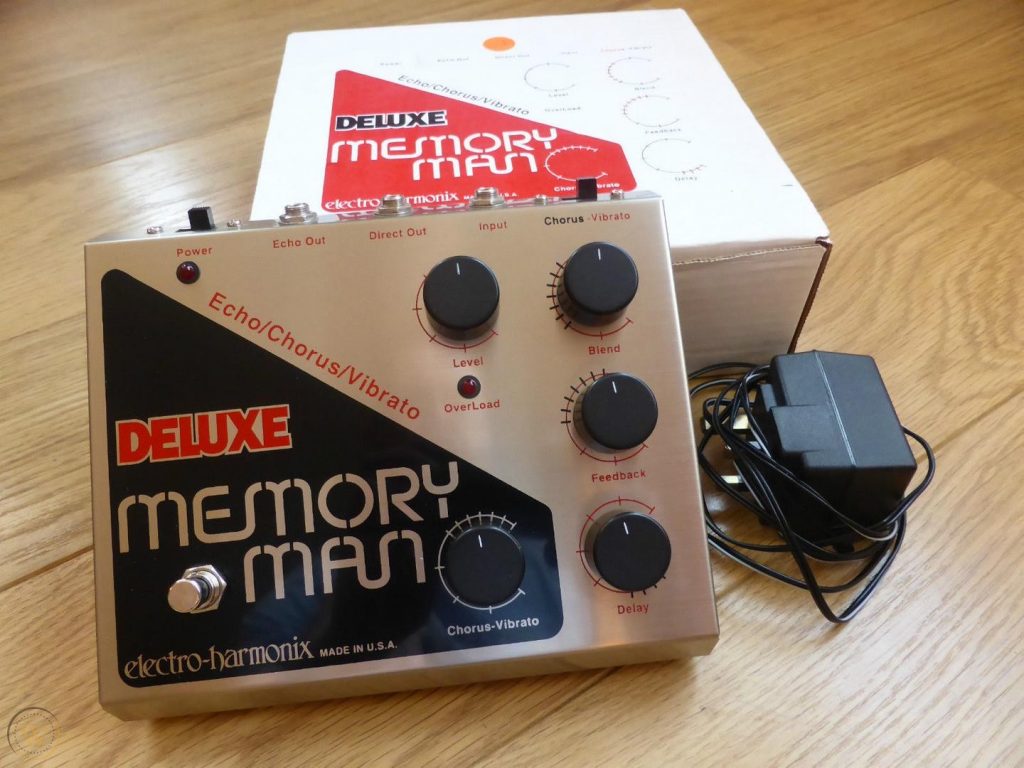
Although I find that the first production Memory Man Deluxe offered a slightly deeper and more liquid sounding modulation, the 90s reissues are only marginally behind.
Generally, but not exclusively, the delay time of the 90s reissues seem a little longer than first production models.
Delay times
Which brings us the delay time – the main reason these units were built in the first place. You are hard pressed finding 2 Memory Man Deluxe units with identical maximum or minimum delay time.
At one point I owned over 8 of these units from various production periods and still have 2 of these on my effects board and I was never able to use the same delay knob settings between any of these units.
Ever since the 90s reissues were introduced, Electro Harmonix claims delay time of “up to 500 ms – a rather innocent way of saying “it can be 500ms but expect less than that“.
Truth is, most Deluxe Memory Man units will be able to hit a maximum delay time somewhere between 300ms and 400ms. The longest delay time of the units I owned was in the 450ms region, the others had much shorter delay times.
But it’s a good idea to bear in mind that the unit is marked as an ‘echo’ not a ‘delay’ – although technically similar, an ‘echo’ is possibly a shorter repeat than a ‘delay’.
And it doesn’t stop here. Select from modulation, a rich chorus on the repeats, or vibrato, and increase the Modulation knob, you add a shimmering flair on your repeated notes that takes your sound into a different universe.
Interesting is that when adding modulation, you also alter the delay time. It’s only marginally audible, but when you need exact delay, this is worth keeping in mind. Another lovable oddity of the Memory Man Deluxe.
Rules are there to be broken
Not calling for a revolution here – but sometimes you have to throw out the manual and rule book and start experimenting a little to find things you’d have otherwise missed out on.
The Deluxe Memory Man is such a case. Players have long experimented with short vs long and shortest vs longest delay times, the self-oscillation of the feedback when increased too far is legendary and the weird and wonderful sounds heavily increased modulation can add has been discussed and put on record many times.
Guitarists have used and abused the EH DMM as a delay and echo unit. Some use it as a sophisticated chorus pedal that would sonically sit somewhere between Electro Harmonix’ own PolyChorus and Electric Mistress Flanger pedals.
It’s secret ingredient: The preamp
A cool accidental feature that many don’t make more use of ii is the adjustable preamp and increasing the gain.
Turn down the delay and just hear your guitar. When increasing the gain knob you are effectively overdriving the internal preamp. The overdrive you get out of it is worth this pedal alone.
Carefully adjusting the gain, you can get any tones from mild overdrive to an almost fuzzy distortion but always musical and responding extremely well to your playing.
It’s this feature in combination with added modulation that gave U2’s The Edge its trademark tone.
Add a Stratocaster or a humbucker-equipped guitar such as a Les Paul or, like The Edge, an Explorer into an AC30 and bingo. It’s THE U2 tone many players have spent years and silly cash to get close to. I’ve you past scrolled it, check out this video of U2 performing 11 o’clock tick tock live at Red Rocks in 1983.
You often hear boutique, but also high-street pedal makers claiming they have cloned the “analogue warmth” of the Memory Man – or in Line6’s case (and others), they argue they’ve digitised its tone. And while all these tone makers have done a remarkable job, they overlook the gain feature.
It’s this, which is actually separating the Memory Man Deluxe from the many analogue and analogue-sounding digital delay machines. Worlds apart!
This is the secret ingredient in the recipe and too often overlooked as manuals and rules always claim to “look at the red LED. If it starts flashing, you have to turn down the gain knob” … WRONG!
Use your ears. Don’t let the red LED decide the gain knob position. If you want a clean delay tone, then keep the gain control on a lower setting but I bet many would enjoy the gain slightly raised.
Less is more
So, if the early models and 90’s reissues are pretty similar and only differ between internal vs external power supply, what separates them from the last production models built from, approximately, 2002/2003 until end of production?
The addition of true bypass ruined newer Memory Man versions
I’m only going to whisper it as it potentially kicks open endless debates; it’s the Pandora’s box of guitar effects: The answer that separates the 2 versions is the addition of a true bypass switch.
A super-quick recap of what true bypass is and what’s not …
Let’s get this out of the way first. Yes, I’m not a huge true bypass fan, but I also don’t have an issue with true bypass whatsoever. Like any “feature”, the question is where and when to implement it. What is what you want from it and how to get it?
Clean tone and tone preservation are the usual arguments for true bypass and while true bypass can help achieve this for you, it can also ruin your tone remarkably well and easily if you don’t know how it works and how it works with your rig.
I could go into a long explanation about potential negative impact true bypass can have to the tone of a player uneducated in this field.
None of the pedal makers, including Electro Harmonix, has ever stood up and explained what the true bypass fuss is all about and how to actually implement true bypass effectively into a pedal board. The only company I know of that has taken up that challenge are the guys at The GigRig.
True bypass has become such a buzz word that pedal makers started to implement true bypass switches as a feature and marketing gimmick (...)
True bypass is a technical solution, never a feature and it only really works as part of your wider rig routing approach.Cornel Lazar in "The Sound of Speed"
But true bypass has become such a buzz word that pedal makers started to implement true bypass switches as a feature and marketing gimmick in order to stay competitive in this rather small market in regards to the number of established effects builders. True bypass is a technical solution, never a feature and it only really works as part of your wider rig routing approach.
Electro Harmonix sadly followed this trend like a cow to the slaughter; not considering implications this can have in separating EHX pedals from all other pedals, and with that the creative impact on artists using EHX gear.
But while all this could be argued pro and con for days, the fact that the true bypass switch is also dis/engaging the gain control is a fact.
What do I mean by this?
Imagine you have set your Memory Man Deluxe with a gain setting that gives you an overdriven tone with a good delay setting for the, say, the solo part of a song.
With the True bypass switch you can’t have the gain with the delay being switched off. Pressing the pedal on and off does not only switch the delay on or off but it also activates and deactivates the overdrive or gain. Rather annoying if the gain from the Memory Man is your main tone and all you want is adding delay.
The tone preserving benefits of the True bypass switch are in my opinion not even close to outweigh the benefits of versatility with non-True Bypass model and buying a couple of true bypass pedals is not giving you a better tone. Period.
And for now, let’s leave it to discuss another time …
Quite funny, in one of their last promotion videos for the discontinued version of the Memory Man Deluxe, the company highlights the “secret gain trick” and presents it as a “feature”.
EHX, why has that “secret gain trick feature” disappeared? Yes, they didn’t really think this properly through. See for yourself in the official EHX promo video below.
Missing the richness and warmths from newer models
Moving on, I also find Memory Man Deluxe units built between 2000-2009 having a slightly more nasal tone. I can’t explain why and I’m gladly stepping away from any argument that says I’m just biassed to the old models. Maybe I am, but that’s what I felt when doing a 1:1 comparison between units.
I’m also feeling the last run of units lacked that deep, rich and warm modulation. The chorus didn’t sound as musical to me as much as the earlier models. In fact, it sounded very ‘standard’ – a tone I’d expect from other manufacturers trying to emulate ‘that Memory Man tone’.
The tone preserving benefits of the True bypass switch are in my opinion not even close to outweighing the benefits of versatility with the non-True Bypass model.
Cornel Lazar in "The Sound of Speed"
So then, let's recap ...
Modding the last production EH DMM’s is more work and might cost you more than actually trying to search the second-hand market for earlier models. Again, look out for the late 70s and early 80s models if you don’t mind a little hum and if you are happy using loads of wall warts.
Personally I find the 90’s reissue the perfect version. You can power discreetly and conveniently with an external power supply – on a pedal board, even use your multi power supply that also powers your other pedals.
At the same time you get the legendary Memory Man Deluxe tone. The 2000-2009 production should be considered the last option.
There’s nothing wrong with them! In fact, they’re actually really good but it’s the true bypass and I know that I could not live with the true bypass “feature” – it would be a nightmare for the tone and settings I need. You have to ask this yourself: If you think this works for you then eBay and similar sites will be ready for you to start searching and I guess it almost doesn’t matter which version you can find.
For those who are looking to avoid certain DMM production periods, be aware of myths
- The often read rule that vintage Memory Man units used tapered knobs and reissued flat round ones is totally wrong. A quick look at old promo images by Electro Harmonix will reveal that flat and tapered knobs were both used from the start. I assume this was a supplier issue.
- The type of knobs/dials on a DMM is NOT an indicator if your unit is vintage, reissue or updated reissue. Besides, knobs are easy to replace and the Memory Man ones can easily get loose and lost.
- I heard rumours that the black back plate can have rounded and pointed corners. Honestly, I’m not sure. I heard this only recently – I wish I’d known this earlier to check all my units I used to own. So take this with caution. If you know anything about this, please leave a comment and explain your experience.
- The most obvious difference between the vintage models and reissues is the attached power cord. But it should be pointed out that the early 90’s reissues still came with the internal power supply and with that had the power cord attached. While not being true vintage, this is essentially the same version.
The type of knobs/dials on a DMM is NOT an indicator if your unit is vintage, reissue or updated reissue. Besides, knobs are easy to replace and the Memory Man ones can easily get loose and lost.
Cornel Lazar in "The Sound of Speed"
Fishing out the non-true bypass from the true bypass reissues is a tough job. Frankly, your best bet is to contact the seller and ask to test the pedal. Ask if he can raise the gain knob play through it and engage and disengage the delay with the footswitch.
If the tone changes between clean and overdriven, you know that you are dealing with a True bypass pedal. If the overdriven tone stays and only the delay goes on and off, the seller is offering the rather great non-True bypass reissue for sale.
So, that’s all folks!
I hope my experience will help some of you. If you feel I left something out, or you believe I was wrong on points, please comment below. Feel free to ask questions, or answer questions and I would love to hear your own Memory Man Deluxe experience in the comments section below.

